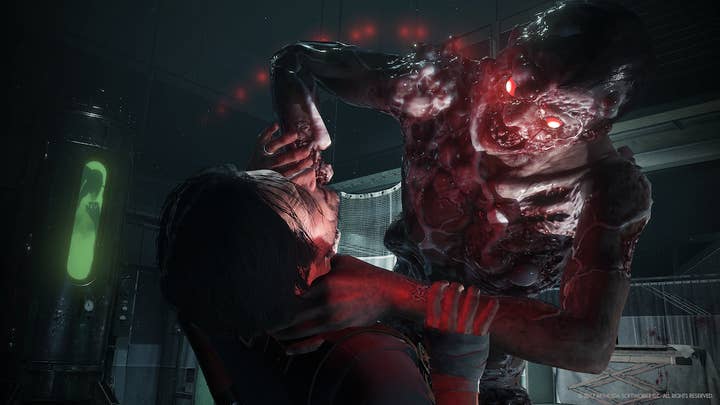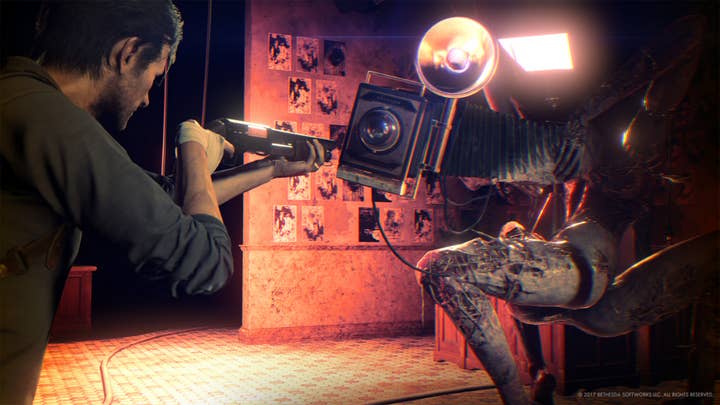The Evil Within 2: Critical Consensus
Bethesda remains committed to single-player AAA games, and most critics agree that Tango Gameworks' sequel is a big improvement
Events of the last few weeks have led many to question the health and even the continued existence of the story-driven, single-player AAA game.
The cost of making such games is rising far quicker than their audience is growing, and the monetisation techniques employed to balance the books (loot boxes, as if you had to ask) tend to fit more snugly in multiplayer products - or at least those operated as year-round services.
When EA decided to rethink a ludicrously exciting Star Wars project led by the ludicrously talented Amy Hennig, many took it as a sign that richly imagined, skillfully told solo adventures were no longer viable. Hands were wrung. Memories of Visceral's Dead Space were discussed in hushed, wistful tones.
Proclamations of the "death" of anything tend to be misguided, and that was certainly true of those reading the last rites to single-player AAA games. Not least because some of the year's best games are wonderfully realised examples of just that (Zelda, Horizon: Zero Dawn, Shadow of Mordor), but because Bethesda still exists and seems hell-bent on making as many of them as possible. This year it has already released both Prey and Dishonored: Death of the Outsider; this month alone it will release both Wolfenstein II: The New Colossus and The Evil Within 2.
"These are ideas the likes of Ubisoft Montreal have long since bled dry"
Eurogamer
Of course, one can question just how well any of those games has - or, in the case of Wolfenstein, will - performed commercially, but a lack of concrete sales figures tends to tell its own story. Certainly, The Evil Within 2 has made an inauspicious start in the UK, selling 75 per cent fewer retail copies at launch than its predecessor. Even when one takes into account a higher proportion of digital sales, it's probably no stretch to say that Bethesda may have hoped for more.
Fortunately, the critics seem to have been given just what they wanted. Despite The Evil Within 2 beating its predecessor's Metacritic average by only 1 per cent - 76 per cent for the PS4 version, versus 75 for the first game - virtually every review opens with a revisionist summary of the series' history. Critics mostly seem to agree that, at the second attempt, Shinji Mikami's Tango Gameworks has righted wrongs and addressed flaws of the first game, even if they have awarded a better experience with similar scores overall.
Eurogamer awarded The Evil Within 2 no score, and its take is certainly one of the least effusive out there. The lack of excitement seems largely down to the game's shift in focus from more linear, tightly controlled levels to, "generously proportioned urban maps - each packed full of crafting resources, upgrades, collectibles and backstory documents, and pegged down by safehouses where you can assemble weapons and ammo, save the game and accept optional missions from conveniently useless side characters.

"While roaming and foraging you'll call upon a chunky Communicator that lets you track objectives and tune into recordings of past events, in echo of Tom Clancy's The Division. You'll also contend with a greater emphasis on stealth and terrain tactics than in the previous game... These are ideas the likes of Ubisoft Montreal have long since bled dry, and initially, their presence here feels abominable - like asking the Babadook to wear a ghillie suit, or handing Freddy Krueger a sniper rifle."
Play spaces like these are not a million miles away from those that could capably host a loot box, of course, but while Eurogamer suspects The Evil Within 2 of being somewhat cynical in its construction - "a forced reconciliation between Mikami's eccentric vision and a 'safer', more callous species of action game" - it's important to note that there are no such random crates to be found in Tango Gameworks' world. Indeed, the majority of critics take a far warmer view of the series' decision to come out into the open.
"Gone are the cramped spaces of the original game, replaced with an opportunity to approach enemies in a variety of ways"
Waypoint
Waypoint, for example, praises this "shockingly good" sequel's new emphasis on "exploration, experimentation, and ample time to hide, scheme, ambush." The Evil Within gave few any reason to expect much from a second game, it said, but despite looking broadly similar at first glance, this is "much more forgiving and playful... It's a game about creativity, rather than scarcity."
"The first hour doesn't communicate what The Evil Within 2 is really up to. It's your standard haunted house, with the player running through creepy hallways and wincing at noises coming around the corner. The moment you reach the game's first 'safe house,' where you can upgrade equipment and take a sip of coffee to refill your health, everything changes.
"Outside the safe house is a sprawling environment. While a handy radio will point you in the direction of side missions, most of the area is a giant unknown, meant to be be slowly picked apart, as you poke away at the dark. Gone are the cramped spaces of the original game, replaced with an opportunity to approach enemies in a variety of ways."
These open spaces - all of which are contained within a simulated US town called Union - do not prevent The Evil Within 2 from becoming, as Polygon describes it, "batshit weird" when it wants to be. Polygon's 9 out of 10 review may be the most positive currently published, and that is largely down to the very element that left Eurogamer cold.
"Union may be a fake alternate reality where you can travel through computers to get from location to location, but Tango Gameworks puts in the effort to make it feel like a real, recognizable, lived-in place - albeit one that has sunk into devastation and terror."

The "side objectives" accessed through the Communicator can lead to the mundane ("resource drops"), but they can also reveal "completely new areas and fully fleshed-out subplots" - a potentially foolhardy game of chicken with the player's patience, but one that Polygon clearly relished.
"I'm astounded by the way that The Evil Within 2 takes light 'open-world' gameplay and makes it work within a horror context... I'm still not sure how Tango Gameworks accomplishes this, but even as I've run up and down the same street for the sixth time, it keeps throwing surprises at me. On my initial pass, I'll clear a garden full of enemies. The next time through, a new one has spawned in a just-hidden-enough location to make me jump with surprise. Or I'll run past a house I've already rummaged through, but I'll hear a woman screaming, pulling me back to find something new and shocking."
"One of my favourite survival horror experiences to date"
Rock Paper Shotgun
And the game's capacity to shock is down to its eye for detail. Rock Paper Shotgun, which was almost as enthusiastic as Polygon, took particular delight in the "environmental and visual storytelling," which applied as much to the creature desigsn as the abandoned, drecepit homes of Union.
"The Guardian, who you meet early on, is a powerhouse of feminine anger, a three-headed monstrosity wielding a giant buzzsaw. She's a creation of the game's first act villain, an art school reject who uses the imaginary nature of Union to create a living art project celebrating the beauty of death and dismemberment.
"Then there's my personal favourite creature design, the Obscura. She's a gangly multi-limbed beast with a camera as a head. Every time she takes a step, something in the construction of her body causes her to sexually stimulate herself. So you're there, trapped in a makeshift darkroom lit by seedy red lights, pursued by a camera-headed woman-thing who orgasms as she scuttles after you, her naked flesh quivering in anticipation for the kill.
"There's no overt backstory to Obscura. She's a creation of the villain, reflecting his vision of art and beauty, something which the game does explore. A psychosexual horror that plays on fears unspoken, turning the game's fairly simplistic plot into a much deeper, more interesting piece of horror fiction."
All of which sounds like a far cry from a cynical tilt at grafting open-world systems and mechanics onto a linear adventure game. Instead, The Evil Within 2 appears to represent progress: in the eyes of Eurogamer perhaps only incremental and not quite enough; in the eyes of Polygon enough to be "the best-paced horror/action games I've played in years," and for RPS "one of my favourite survival horror experiences to date."
Whatever The Evil Within 2 sells, then, Bethesda can at least take comfort in the fact that, as a creative work, it has yet another single-player series that remains both alive and well.
